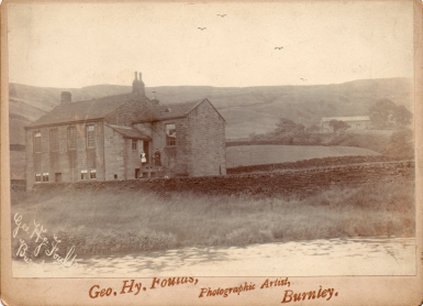
The Calder Valley main line from Manchester via Summit Tunnel and Walsden
to Halifax and Leeds
The line that defined the Lancashire and Yorkshire Railway and which formed its backbone was George Stephenson's Manchester and Leeds Railway which penetrated the Pennine watershed through the remarkable Summit Tunnel. Today, we would say the tunnel was 'over-specified' but Stephenson did not have the benefit of computer science and so built with the best materials to hand, and to a high specification. On its completion in 1841, Stephenson honestly described it as 'the greatest work that has yet been done of its kind'.
His work was sorely tested some 143 years later when early on the morning of Thursday 20 December 1984 a fully-loaded train of tanks from the ICI depot Haverton Hill, Teeside to Runcorn in Cheshire derailed in the tunnel. The tanks ruptured and the subsequent fire and explosion was caught on film, and the YouTube clip can be viewed below.
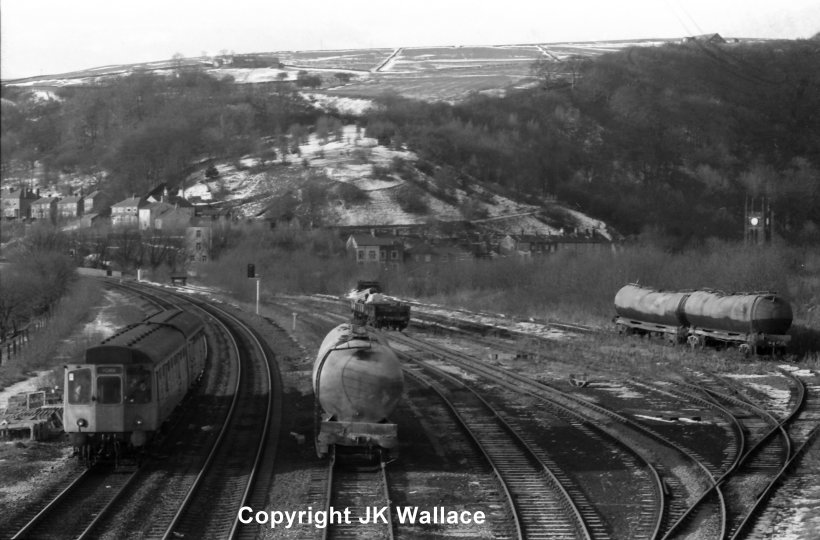
Photographer Stephen Chapman; copyright JK Wallace
Hall Royd Junction engineering sidings with three surviving tankers dragged down from Summit Tunnel following the fire as seen in January 1985. A York bound three-car Class 110 passes the site wrong line, possibly regaining the Down line using the cross-over at Hall Royd Junction proper. This cross-over did not have a facing point locks, so would have to be manually clamped for passenger train usage.
British Rail organised an Emergency Service which operated from 21 January 1985 through to 12 May 1985 which involved an emergency rail/bus service. This saw all Manchester bound trains terminating at Todmorden, with buses provided between Todmorden and Littleborough, and then train from there into Manchester. Below is a copy of the Emergency timetable, and curiously it does not include Sundays, as it brightly says 'Sunday services are not included as they will be affected by additional Emergency Work, and passengers area advised to contact their local station for full details'.
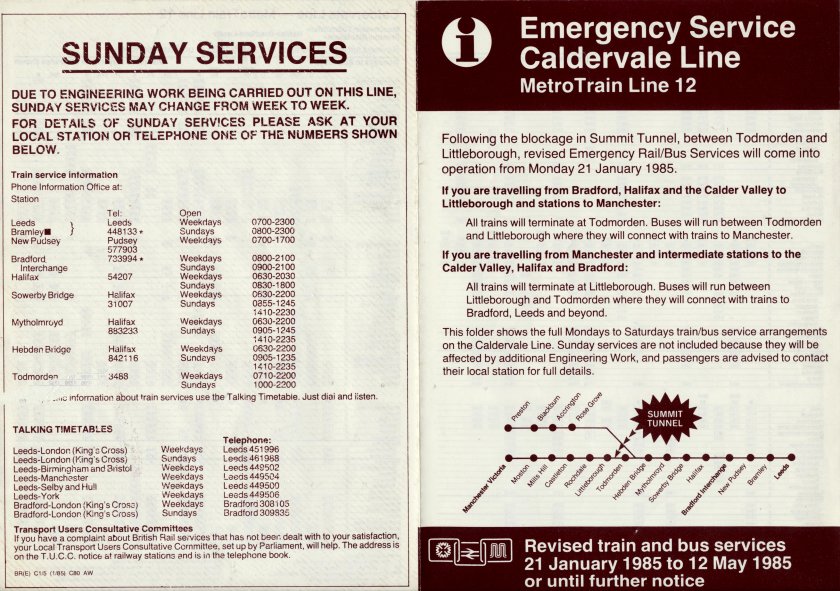
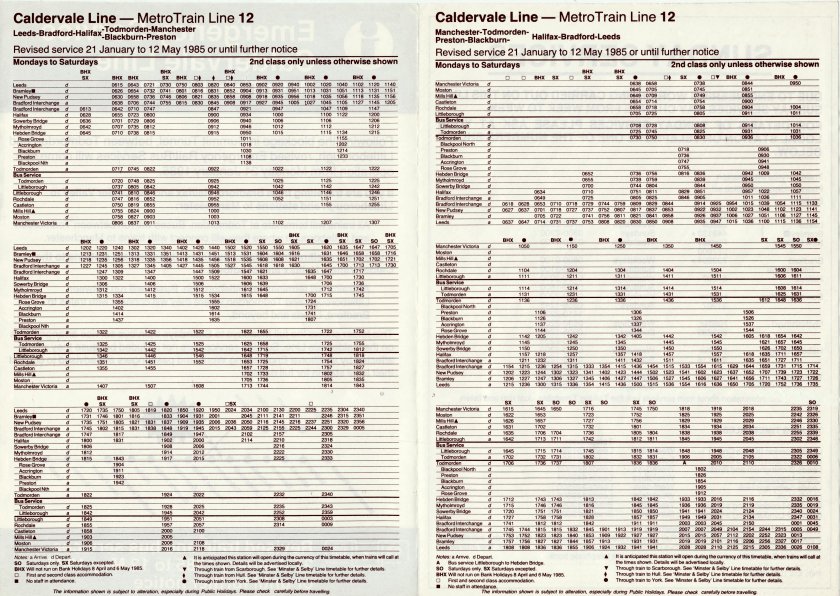
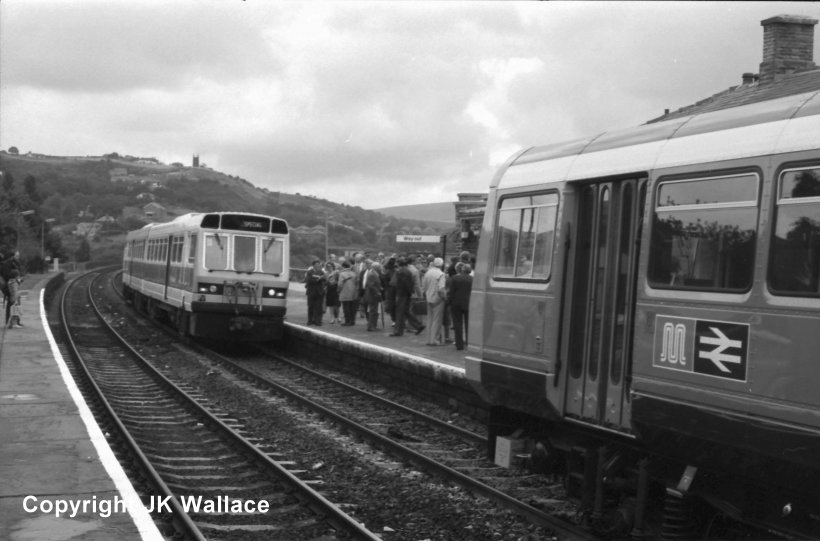
Photographer Stephen Chapman; copyright JK Wallace
Summit Tunnel was reopened to traffic on 19 August 1985, and on the day two two-car Pacer Trains were caught in the Up platform at Todmorden. The nearer unit is 142001, whilst a Class 141 stands behind it.
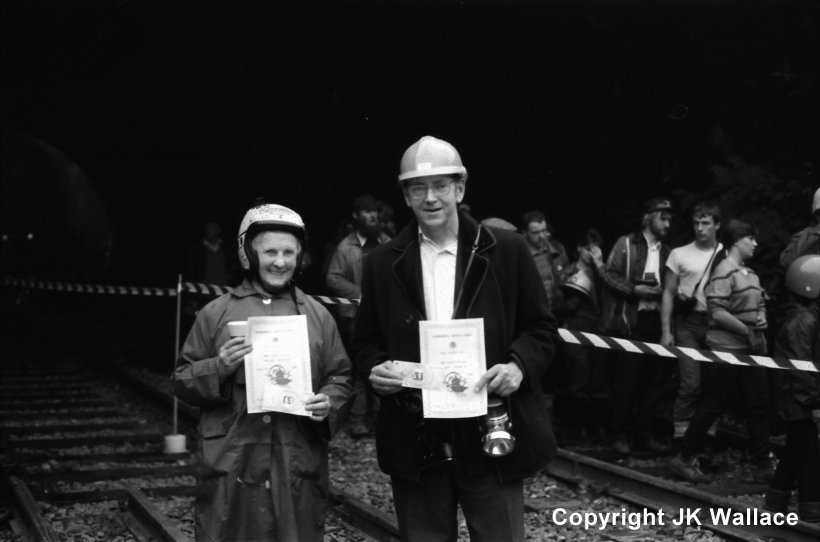
Photographer Stephen Chapman; copyright JK Wallace
Stephenson's last known surviving relative Robert Stephenson Roper (and presumably Mrs Stephenson Roper) at the Todmorden end of Summit Tunnel during the charity walk through the tunnel on 17 August 1985, two days before the reopening following the devastating fire on 20 December 1984.
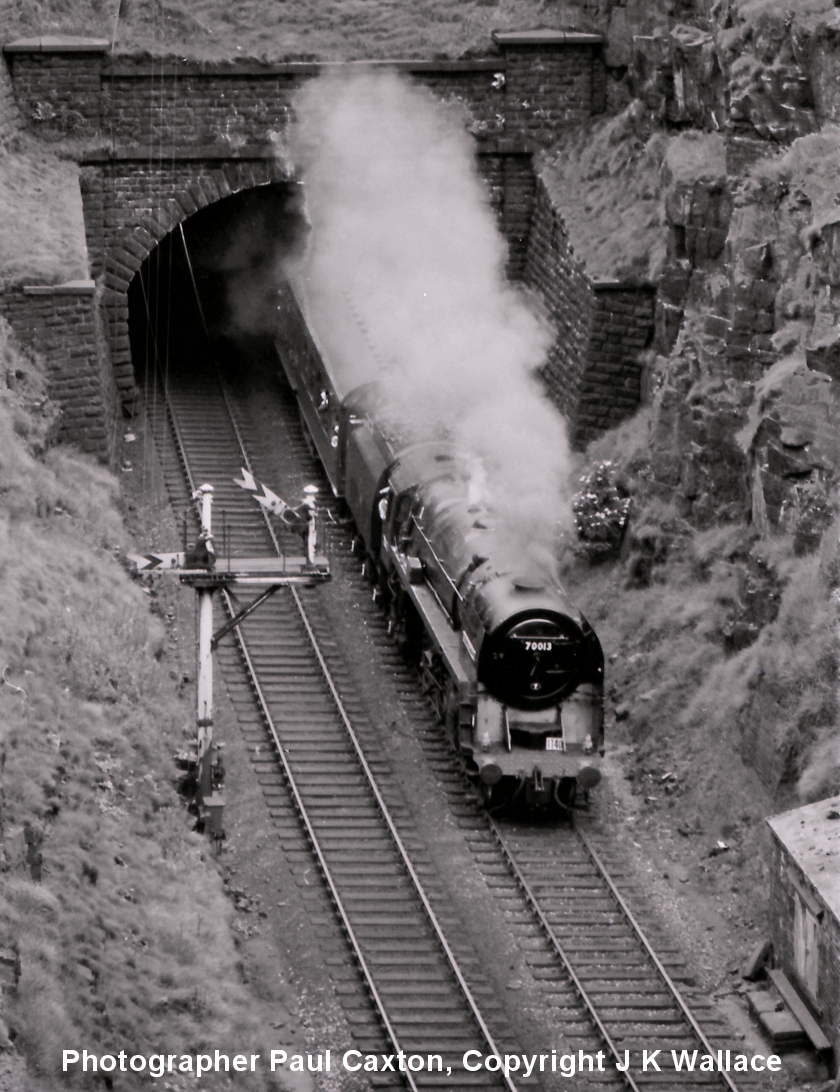
BR Standard Pacific 70013 'Oliver Cromwell' exits from Summit Tunnel on 21 July 1968 with 1T40. Note the splitting distants for Summit West. The Six Bells Junction Website records that this was a Roch Valley Railway Society Manchester - Southport excursion. 'Oliver Cromwell' worked the second leg of this three leg tour, and took over the train on the Southport avoiding curve and then ran via Wigan Wallgate, Crows Nest Jnc, Bolton, Clifton Jnc, Windsor Bridge No.3, Manchester Victoria, Cheetham Hill, Rochdale, Todmorden, Copy Pit, Rose Grove, Blackburn, Lostock Hall, Moss Lane, Burscough North Jnc, Burscough Bridge, Meols Cop and Southport Chapel Street.
The entrance to Summit Tunnel is not the obvious portal, but is in fact 41 yards further into the hillside. The true portal is marked by a large ventilation shaft that does not appear on the original plans. In the January 1956 issue of 'Trains Illustrated' K Field suggests reasons for the various lengths of the tunnel quoted. One is that to-day's figure includes the false entrance under the Todmorden - Rochdale road , or alternatively that the east entrance was once nearer the Rochdale road, but that part of the cutting leading to it was later roofed over. This end of the tunnel is very near the surface and for some odd reason there is an air vent only 40 yards from the tunnel mouth.
In the Network Rail list of bridges, Summit Tunnel has three numbers allocated to it: Summit West (89), Summit (90) and Summit East (91). The ventilation shaft next to the Bottomley Road therefore marks the division between Bridges 90 and 91.
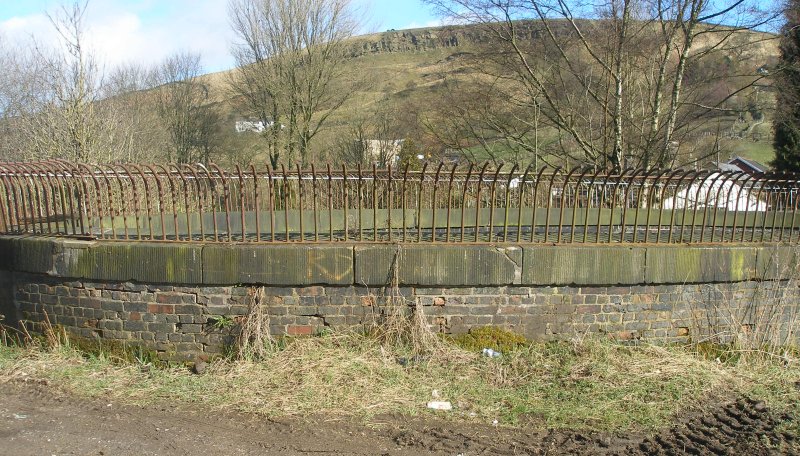
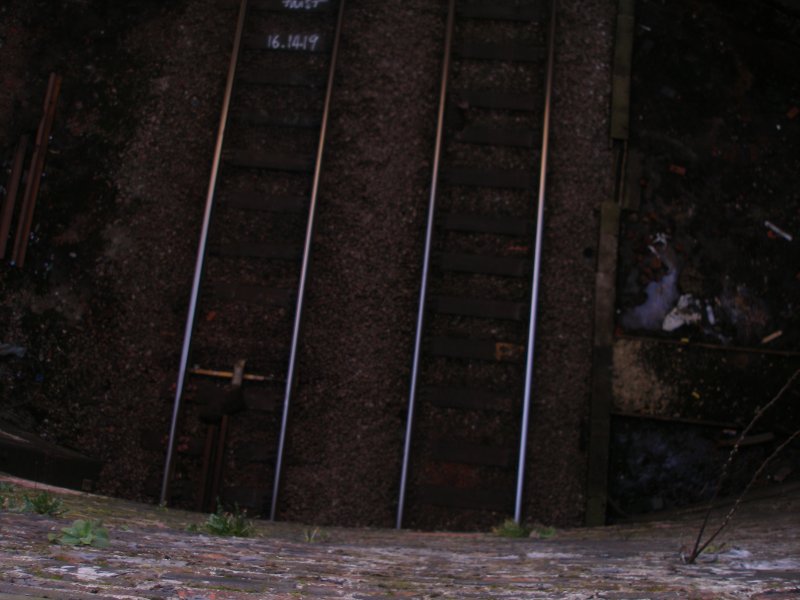
At the other end of the tunnel the line emerged from a very splendid portal before entering the short Summit Tunnel West. After which a pair of loops sprang off on both the Up and Down side. Chris Littleworth has kindly provided the signal box diagram for Summit West.
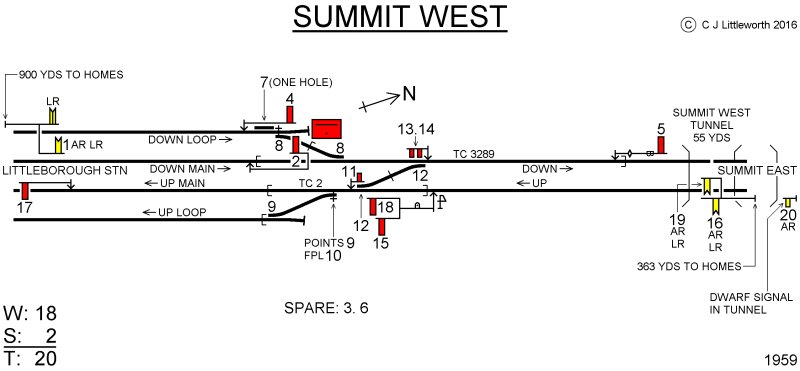
BR Standard 73069 and Stanier Black 5 44949 approach Summit West tunnel on 18 May 1968. According to the Six Bells Website, this was the Warwickshire Railway Society's North Western Steam Tour which also used locos D3783, D7515, E3058 and 70013. It started and finished in Coventry, and 44949 and 73069 powered the Stockport Edgeley - Ashton Moss Jn - Brewery Curve - Castleton - Rochdale - Todmorden - Rose Grove - Blackburn - (via Bolton avoiding line) - Preston leg. The tour subsequently took in Blackpool North, and Morecambe Promenade before 44949 and 73069 again powered the train from Morecambe Promenade to Stockport Edgeley.
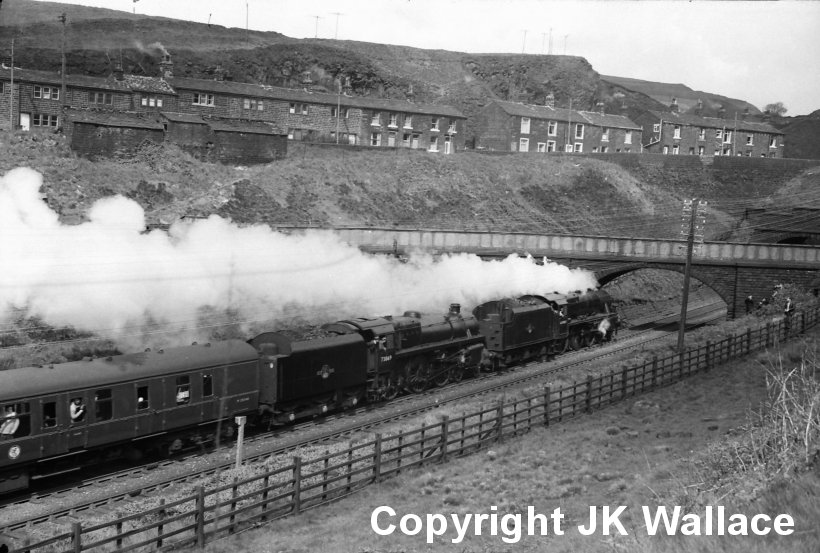
Copyright JK Wallace; all rights reserved
Very close to the Yorkshire mouth of Summit Tunnel was Bottomley Road, which winds down past the railway and crosses the canal. On the other side of the canal was Lane Bottom School, Walsden. As I happen to have a photograph of the school in my collection I have no hesitation in including it here.
The photograph is thought to be taken about 1895 and shows School Mistress Mrs Emily Alexandra Hayes and her daughter on the steps looking towards Todmorden, probably watching a train slogging its way up the gradient towards the tunnel, of which they would have an excellent view, or more prosaically, they could just be looking at the photographer. The school was erected in 1818, originally known as Bottomley Lane Foot. It was situated on the Bottomley side of the canal, just over the bridge at the bottom of the lane, and finally demolished in the 1960s to be replaced by housing. Miss Hays also became a teacher and was teaching in the Vale Council School, Cornholme in 1910.
The reason for its inclusion here - apart from fitting the geographic narrative - is that the ladies are my Great Grandmother and Grandmother.
The school inspector's reports still survive on microfiche in Halifax Library (early 2015). The 1892 November reads:
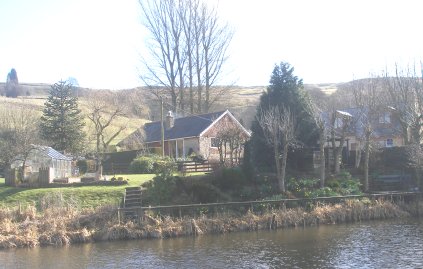
Head Teacher ... Mrs Hayes
The scholars are orderly and the elementary work is done well, the written arithmetic deserving special praise for neatness and accuracy. Writing has improved, but still suffers from the bad way in which the pens are held. The teaching would probably be more effectively given if the suggestions made in the instructions to H M inspectors respecting the grouping of standards were more fully adopted. Mrs Hayes will receive her Certificate in due course.
My grandmother also became a teacher in Todmorden, latterly up at Cornholme. After the family moved to Southport, my Grandfather, possibly uniquely, then proceeded to commute from Churchtown on the Southport-Preston line to Todmorden on a daily basis, maintaining an interest in the family business until its closure in 1927.
